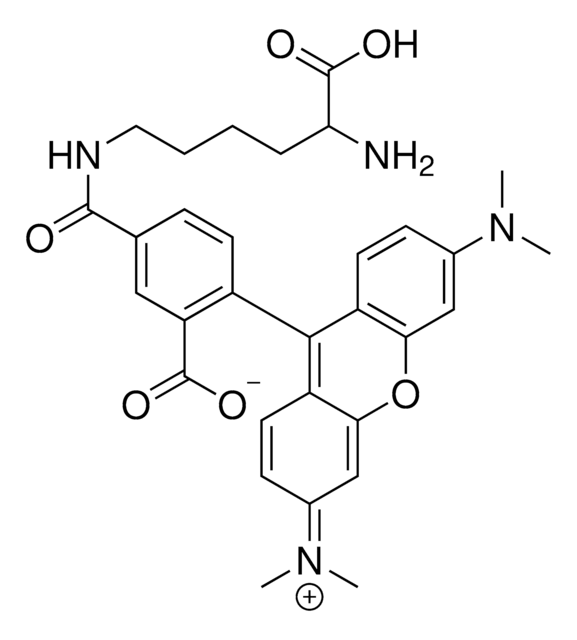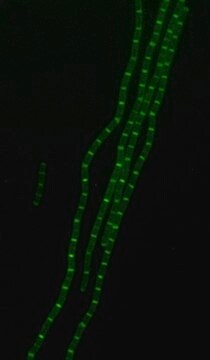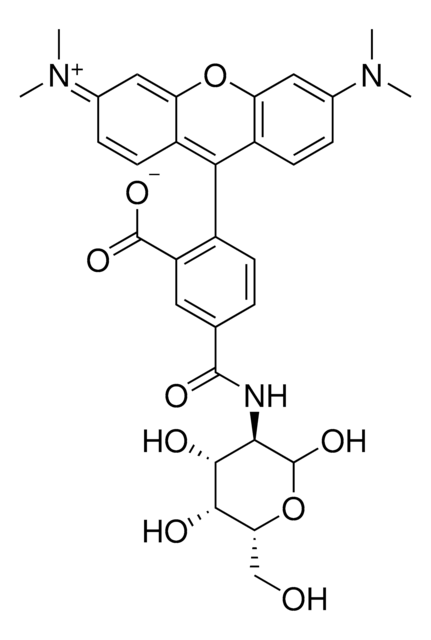추천 제품
일반 설명
Bacterial Peptidoglycan is a polymer consisting of sugars and amino acids, a mesh-like rigid layer that forms the cell wall. D-Amino Acids (D-AAs) are metabolically incorporated onto the bacterial cell wall by D,D-transpeptidase and/or L,D-transpeptidase. It was recently discovered that those transpeptidases catalyze the metabolic incorporation of exogenous D-AAs with almost no restriction of the side-chain identity. Modification of a D-AA with molecular fluorophores provides fluorescent d-amino acids that can efficiently label in situ peptidoglycan in diverse bacterial species.
Fluorescein Labeled D-Alanine is a fluorescent derivative of D-alanine that is obtained by a synthetic conjugation of 3-amino-D-alanine to a fluorophore. Fluorescein Labeled D-Alanine has high biocompatibility and suitability for labeling peptidoglycans in live bacteria
Fluorescein Labeled D-Alanine is a fluorescent derivative of D-alanine that is obtained by a synthetic conjugation of 3-amino-D-alanine to a fluorophore. Fluorescein Labeled D-Alanine has high biocompatibility and suitability for labeling peptidoglycans in live bacteria
애플리케이션
Fluorescent labeled D-AAs can be used for many applications including:
- Bacterial cell wall morphology
- Bacterial cell wall formation or remodeling activity
- Bacterial viability/activity
- Identify bacterial activity on surfaces or in substances
분석 메모
- Fluorescent microscopy application: Fluorescein Labeled D-Alanine has excitation/emission wavelength range at 495 nm/515 nm.
- The recommended working concentration in fluorescent microscopy imaging application is between 250 μM-500 μM in DMSO.
- Aliquots of the DMSO solution can be stored at -20°C, protected from light for at least one month.
Storage Class Code
11 - Combustible Solids
WGK
WGK 3
Flash Point (°F)
Not applicable
Flash Point (°C)
Not applicable
시험 성적서(COA)
제품의 로트/배치 번호를 입력하여 시험 성적서(COA)을 검색하십시오. 로트 및 배치 번호는 제품 라벨에 있는 ‘로트’ 또는 ‘배치’라는 용어 뒤에서 찾을 수 있습니다.
Helene Botella et al.
mBio, 8(5) (2017-09-14)
Peptidoglycan (PG), a polymer cross-linked by d-amino acid-containing peptides, is an essential component of the bacterial cell wall. We found that a fluorescent d-alanine analog (FDAA) incorporates chiefly at one of the two poles in Mycobacterium smegmatis but that polar
Yen-Pang Hsu et al.
Chemical science, 8(9), 6313-6321 (2017-10-11)
Fluorescent d-amino acids (FDAAs) enable efficient in situ labeling of peptidoglycan in diverse bacterial species. Conducted by enzymes involved in peptidoglycan biosynthesis, FDAA labeling allows specific probing of cell wall formation/remodeling activity, bacterial growth and cell morphology. Their broad application
Felipe Cava et al.
The EMBO journal, 30(16), 3442-3453 (2011-07-28)
Production of non-canonical D-amino acids (NCDAAs) in stationary phase promotes remodelling of peptidoglycan (PG), the polymer that comprises the bacterial cell wall. Impairment of NCDAAs production leads to excessive accumulation of PG and hypersensitivity to osmotic shock; however, the mechanistic
Erkin Kuru et al.
Angewandte Chemie (International ed. in English), 51(50), 12519-12523 (2012-10-12)
Tracking a bug's life: Peptidoglycan (PG) of diverse bacteria is labeled by exploiting the tolerance of cells for incorporating different non-natural D-amino acids. These nontoxic D-amino acids preferably label the sites of active PG synthesis, thereby enabling fine spatiotemporal tracking
자사의 과학자팀은 생명 과학, 재료 과학, 화학 합성, 크로마토그래피, 분석 및 기타 많은 영역을 포함한 모든 과학 분야에 경험이 있습니다..
고객지원팀으로 연락바랍니다.








